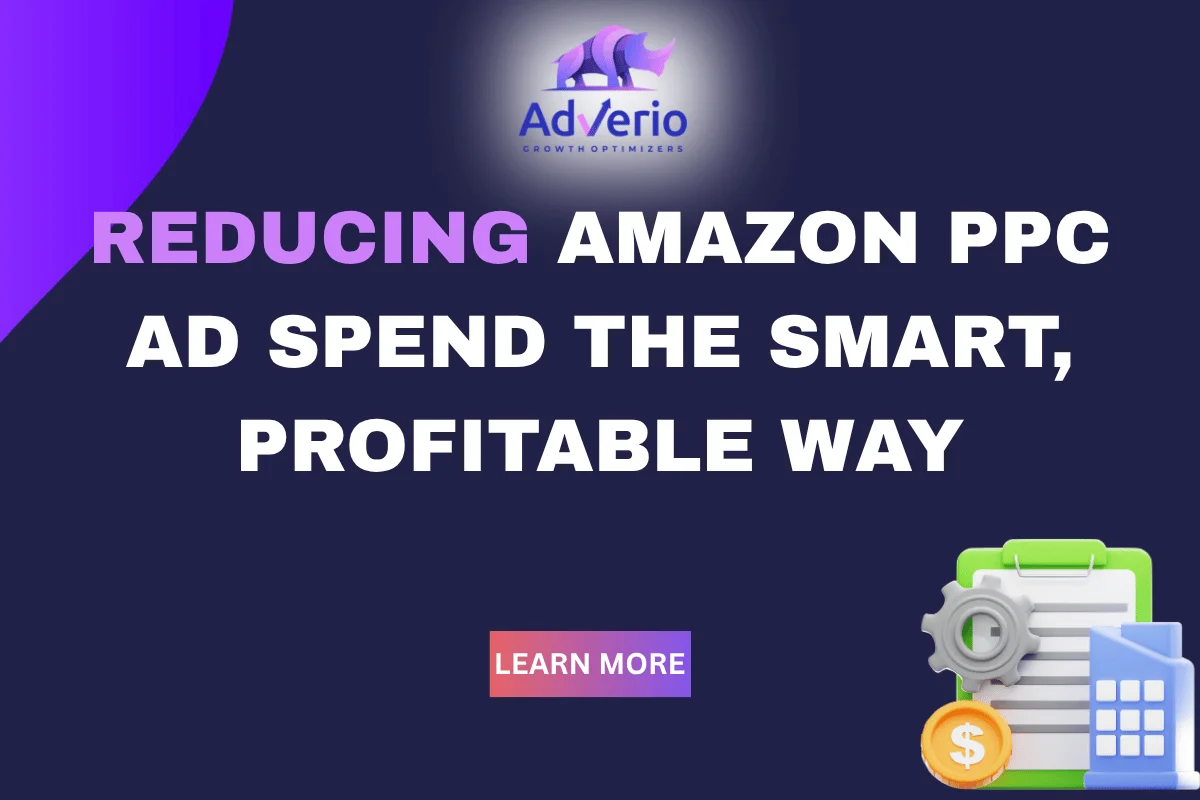Table of Contents
Some brands slash bids, pause campaigns, and call it optimization.
But instead of reducing Amazon PPC ad spend, they sabotage growth.
Amazon rewards consistent visibility, and if you cut too hard, you’ll pay twice later to recover rank and traffic.
This post breaks down how to:
- Cut wasted spend without shrinking sales
- Pinpoint where your budget leaks
- Turn your saved dollars into incremental profit
TL;DR – Ways to Reduce Amazon Ad Spend
Here’s a quick rundown of how to reduce the cost of Amazon ads:
- Trim branded spend
- Split campaigns by placement
- Temporarily automate bid adjustments
- Rebalance spend by SKU
- Keep negatives alive
- Target long-tail intent
- Focus on incrementality
Adverio guides 7- and 8-figure brands to optimize their
Amazon seller advertising costs. If you want to spend less and earn more, we can help you, just like we helped Tribe Organics double sales while cutting ACoS from 50% to 35%.
Get your free ROI forecast to see how much more profit your current spend could generate with the proper adjustments.

Wasted PPC Spend Eats Your Profits Alive (And How to Avoid These Pitfalls)
Most wasted ad dollars come from:
- Paying for clicks you’d get organically.
- Competing with yourself through overlapping campaigns.
- Running auto-bids long after they’ve stopped converting.
- Placing ads on Product Pages that drain the budget but rarely close.
- Ignoring the long-tail and negative keywords.
To avoid these pitfalls in the first place, you should:
- Structure campaigns intentionally to see which ones drive growth.
- Refresh campaign data weekly to catch shifts in conversion rate or CPC before they erode profit.
- Align spend with profit goals so a good ROAS doesn’t hide a weak margin.
- Check keyword overlap to ensure different campaigns target different terms.
- Reassess placements regularly to keep your spend focused on high-performing positions.
If your Amazon ad costs are structured around profit, not vanity metrics, you won’t have to cut spend later to stay efficient.

Metrics That Show Where Your Amazon Ad Budget is Leaking
By tracking both health (structural soundness) and efficiency (profit impact), you can see in minutes whether your ads are fueling growth or quietly burning cash.
Here are the diagnostic metrics:
1. ACoS vs. Profit Margin
If your ACoS exceeds your product’s profit margin, it erodes growth. Track it alongside Net Margin to confirm that campaigns add incremental profit.
2. TACoS
A falling TACoS shows your ads are lifting organic rank. If it rises, your ad spend is inflating without long-term gains.
3. Spend-to-Sales Ratio by SKU
Compare each SKU’s share of ad spend to its share of total sales.
If one product gets 25% of your Amazon ad budget but contributes only 10% of revenue, that’s a clear imbalance.
3. CVR
Falling CVR with rising CPC is a warning sign of misaligned targeting, poor listing quality, or keyword fatigue.
Any keyword or target with 20+ clicks and no sales is a silent budget drain.
Even at $0.50 CPC, that’s $10 burned on traffic that didn’t convert, and it compounds across dozens of keywords.
4. Placement Breakdown
Check the conversion rate and cost by placement in your Placement Report.
If Product Page placements eat most of your budget but convert 3–4X worse than Top of Search, you’re funding exposure that doesn’t sell.
5. Branded vs. Non-Branded Purchase Share
Use your SQP report to compare revenue from branded vs. non-branded searches.
If branded sales stay steady after reducing branded spend, that budget wasn’t driving incremental growth.
6. Search Term Efficiency
Your Search Term Report reveals which queries trigger your ads.
Flag the low-relevance terms that get clicks but no sales. It’s where the first PPC leaks appear.
7. CPC Trend Line
If your average CPC keeps climbing while conversions stay flat, you’re probably stuck in inefficient bidding loops. Check for keyword overlap or outdated bid rules.
8. CPA by Placement
Beyond ACoS, CPA by placement shows the cost to actually win a sale on each placement.
A high CPA on Product Pages or Rest-of-Search means those placements are draining profit even if the ROAS looks acceptable.

7 Strategies for Reducing Amazon PPC Ad Spend without Losing Sales
Rather than spending less, you should spend smarter. That starts with selective reduction, where you trim waste and double down on what drives profit.
1. Isolate and Reduce Branded Keyword Spend
Paying for clicks you’d win anyway is one of the most common mistakes of Amazon PPC. Branded campaigns often eat up budget that delivers little incremental value.
Start by reviewing your SQP report to see how much branded traffic converts organically.
Then, gradually taper your spend on those keywords while tracking branded purchase share.
If sales stay steady, you’ve found a budget you can safely reallocate. The goal is to free funds for generic or competitor terms that drive new sales, not to eliminate branded ads.
2. Separate Campaigns by Placement
Amazon’s default placement mix automatically distributes bids across Top-of-Search, Rest-of-Search, and Product Pages. Often, it pushes far too much spend toward low-conversion detail pages.
To scale high-performing Top-of-Search exposure while capping inefficient placements:
- Duplicate campaigns and isolate placements, one for Top-of-Search, one for Product Pages.
- Assign zero bid multipliers to unwanted placements so budgets can’t drift.
This way, you’ll cut ACoS and improve ROAS, not by reducing reach, but by focusing spend only where it converts best.
Resource: For a deeper dive into placement-based optimization, check this 3-part guide:
- Part 1: How to duplicate campaigns for placement-specific control
- Part 2: How to structure placement-specific campaigns
- Part 3: How to implement placement-specific campaigns (step-by-step)
3. Use Rule-Based Bidding to Cut Inefficient Clicks Automatically
Manual bid changes can’t keep up with real-time performance shifts.
To prevent over-spending on weak performers while maintaining strong bids for profitable keywords, run automated adjustments. These will work 24/7, trimming fat while keeping top-converting placements active. You’ll reduce cost per sale without throttling traffic.
For instance, if you’re a mid-sized brand looking to transform your Amazon PPC strategies, set simple rules such as:
- Decrease bids by 15% when ACoS rises above 40%
- Increase bids by 10% when ACoS falls below 15%
- Pause any keyword with 20+ clicks and no conversions
We break down the bidding tactics for small, mid-sized, and large accounts in this guide, How to fix underperforming Amazon campaigns.
4. Reallocate Budget by SKU and Profit Margin
Granting every SKU equal ad spend is another way to hurt your Amazon PPC performance.
Compare each product’s share of total sales versus its share of ad spend.
If a mature or low-margin SKU consumes 2–3X its proportional budget, redirect those dollars to high-margin or fast-growing products.
This simple rebalancing ensures your PPC investment supports the most profitable catalog segments, cutting total spend while maintaining (or even increasing) total profit.
Our Profit Pulse System automates this SKU-level visibility, showing where you can reallocate budgets to improve efficiency.
5. Maintain a Living Negative-Keyword System
Negative keywords are one of the easiest ways (and best practices) to stop wasted clicks.
A strong system helps you:
- Keep traffic quality high without sacrificing valuable search volume
- Ensure every click reflects real buying intent
To maintain it, continuously add underperforming or irrelevant search terms as negatives. This will prevent internal competition between campaigns.
Then, run periodic negative resets to re-test previously blocked terms that may have regained relevance over time.
6. Target Long-Tail and Lower-CPC Keywords
“Stainless steel French press coffee maker” beats “coffee maker.”
That’s because broad, short keywords are expensive and often too competitive.
If you target instead the long-tail phrases that signal strong buying intent, you’ll notice you:
- Pay less per click
- Convert at a higher rate (shopper knows exactly what they want)
This strategy cuts CPC while keeping sales volume stable. A double win for profit efficiency.
7. Focus on Incremental Growth Campaigns
The most profitable spend drives new revenue, not repeat clicks.
To acquire it, focus on conquesting competitors, generic search, and Sponsored Display retargeting.
These tactics expand reach, re-engage high-intent shoppers, and grow sales volume while keeping your Amazon advertising budget efficient.

Reducing PPC Spend Can Hurt Sales, Here’s How to Prevent That
Reinvest every dollar you save from optimization into your highest-margin campaigns, and you’ll sustain profitable growth:
- Protect High-Performing Keywords and SKUs: Keep budgets stable for your best-performing keywords and SKUs. They drive consistent sales, build reviews, and reinforce organic rank.
- Reduce Waste Gradually, Not Abruptly: Avoid sharp cuts that reset campaign learning. Trim low performers in 10–15% steps to preserve data and momentum.
- Watch Organic Rank: If spend drops too fast, rankings can fall. Use SQP to monitor visibility and reinstate limited bids where needed to stabilize rank.
- Keep Brand Visibility Steady: Pausing too many branded or Sponsored Brand campaigns lets competitors take your space. Reduce bids strategically and monitor branded purchase share.
- Adjust by Placement, Not by Campaigns: Sales losses often come from over-cutting. Separate Top-of-Search from Product Pages. Scale down where conversions lag and keep investing where they close.
- Track Key Metrics Together: Falling sales after spend reduction are often a sign of cutting too deeply or cutting the wrong areas. Keep an eye on your ACoS, TACoS, and ROAS together. If TACoS climbs after spend cuts, you’re losing organic lift and need to rebalance.
- Set Realistic Next-Steps: Optimization isn’t a one-time project but a system. Need guidance for your in-house operators? Or a team to operate your account end-to-end? Our dual-service model (Done-for-You or Done-with-You) ensures you can apply these strategies with precision and control.

Case Study Snapshot: From Under
Overspending to Profitable Growth
Most brands make a costly mix:
- Underspend on the aggregate, limiting budgets that could drive incremental growth
- Overspend on vanity traffic like branded and IP terms that add little new revenue
We broke down these patterns on The PPC Den podcast, but here’s a concrete example from our portfolio.
When Road Ready came to work with us, their Amazon growth had stalled. Revenue had flatlined, margins held steady, and ad budgets weren’t being deployed aggressively enough to unlock new sales.
Using our Precision Scaling Framework, we:
- Identified the 20% of SKUs driving 80% of revenue
- Reallocated spend from low-impact branded campaigns to high-return SKUs
- Enforced profit-first TACoS and ROI guardrails
The result? +59% revenue growth and +41% profit gains in 18 months, all while maintaining strict margin control across 700 SKUs.
If your ad spend feels “safe” but doesn’t move the profit needle, our team can help turn your conservative budget into an engine of profitable scale.
Request your free ROI forecast to see how much untapped profit your current spend is leaving on the table.

Frequently Asked Questions (FAQs)
Straight answers for smarter Amazon PPC ad spend:
How Much Should I Spend on Amazon Advertising?
There’s no fixed formula, so spend only as much as it takes to stay profitable.
Ad spend should rise and fall with your margins, conversion rates, and goals.
Is It Better to Run Manual or Automatic Campaigns for Lower Costs?
Most brands start with automatic campaigns for discovery and move their top-converting keywords into manual campaigns once they’ve gathered enough data.
At Adverio, we don’t pour budgets into exact-match, manual campaigns that end up overpaying for the same traffic. We use autos, broads, and category targeting to reach the same product pages and audiences at a fraction of the cost.
Discover how our strategy delivers single-digit ACoS in our full breakdown on this episode of The PPC Den Podcast.
Can Using Dayparting Help Lower My Amazon PPC Costs?
Especially in B2B, dayparting can cut wasted spend without losing visibility.
Even B2C sellers can benefit by pairing dayparting with placement modifiers to focus spend on the hours and placements that actually convert.
When Should I Increase, Not Reduce, Amazon PPC Ad Spend?
If a keyword, ASIN, or placement drives low ACoS, strong conversions, and a visible sales lift, that’s where you scale.
Boost your Amazon ad spending when it fuels profitable growth, sustains rank momentum, or protects key placements from competitors.




























